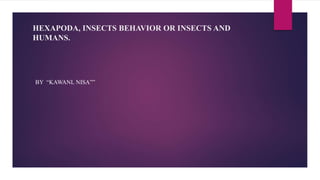
Zoology Phylum
- 1. HEXAPODA, INSECTS BEHAVIOR OR INSECTS AND HUMANS. BY “KAWANL NISA””
- 2. Phylum Hexapoda The hexapods are the most diverse group of invertebrates. Like all arthropods, hexapods have a segmented body and limbs and a thick chitinous cuticle called an exoskeleton. All species have three body parts (head, thorax, and abdomen) and six legs, for which the group is named.
- 3. Locomotion Hexapods exhibit metameric, or repeated, segmentation and have one pair of appendages per segment. These segments are organized into three tagmata, or specialized segments: the head, thorax, and abdomen. Their appendages are jointed, which aids in walking, swimming, and feeding, similar to the joints in our bodies Locomotion of Hexapoda through walking, running and jumping. In walking 3 or more legs evolved ,in running less than three legs are attach to ground and in jumping strong metathorasic leg use for movement.
- 4. Mouths parts Labrum (sensory upper lip). Mandibles (help in food chewing). Maxilla ( help in food cutting). Labium ( sensory lower lip).
- 5. Thermoregulation Thermoregulation is important phenomena in insects. Insects maintain 25°C temperature for flight. If temperature is less than 25°C than they can’t able to fly. 2 types of Hexapods in environment Heterotherms limited metabolic heat produce. Vary body temperature
- 6. Continue…. Heat produce through shivering thermogenesis by flight muscle. Ectotherms Totally depends on sun for heat. Obtain heat from sun.
- 7. Flight mechanism There are two types of flight mechanism. Direct mechanism depends on two muscles. Dorsoventral muscle or Basler muscle. When basler muscle contract then wings move downward. When darsoventral muscle contract wings move upward .
- 8. Continue…… Indirect mechanism Depends on 2 types of muscles Darsoventral muscle contract then wings move downward. When longitudinal muscle contract wings move upward. These muscles are not directly attach with wings 1 nerve impulse= 50 wings beats.
- 9. Insects behavior There are two types of behavior that can be observed in organisms lnnate behavior Innate behavior is genetically encoded. Flight and mating habits are considered innate behaviors clear example of innate insect behavior called the dorsal light reaction. Flying insects will sense the direction of light coming from the sun and fly in a way that keeps the sun overhead, or on their dorsal side.
- 10. Continue……. learned behavior Learned behaviors are those that are not encoded genetically and are not present in the organism at birth. They are obtained through life experiences, and they can change or improve over time. For example, honeybees can be taught to obtain their food from a particular source based on color cues, even when the location of that source changes.
- 11. Insects and humans Insects pollinate many of our fruits, flowers, and vegetables. We would not have much of the produce that we enjoy and rely on without the pollinating services of insects, not to mention honey, beeswax, silk, and other useful products that insects provide. Insects feed on a seemingly endless array of foods. Insects are busy helping humans, wildlife and the environment in many ways,
- 12. Continue….. including: pollinating plants, a process which is essential for reproducing a range of flowers and vegetables. Around 80% of UK plants are pollinated by insects, including a large number of our food crops. Topping our list of helpful insects are bees. Bees in particular are quite helpful to humans. In fact, they are essential to human survival. Honeybees are important because they are responsible for a great deal of pollination.